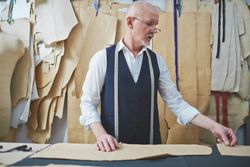
Making your own clothes is a popular hobby for aspiring sewists due to the custom element of this type of project. This benefit can fill a void that many find on the clothes racks at stores if they have longer torsos, bigger busts or butts, or longer legs and want to incorporate flexible fabrics, such as spandex, into their wardrobe. When you’re starting this venture, however, you often depend on sewing patterns to guide your garment-making process, which can create many of the same sizing problems without tailoring. While tailoring plays a crucial role in custom garments, there are many tricks of the trade that can make adapting sewing patterns a lot easier.
Choosing the Correct Pattern Size
What Are Sewing Patterns?
 Sewing patterns act as a template for sewists to work off of for custom making clothes. They are outlines of designs in standard, proportionate sizing that lay the groundwork for a sewing project. Sewing patterns also include instructions that highlight grainline direction, material suggestions, and other recommendations to tackle the project. These included tips are crucial when experimenting with new fabric types, like when sewing with spandex for the first time.
Sewing patterns act as a template for sewists to work off of for custom making clothes. They are outlines of designs in standard, proportionate sizing that lay the groundwork for a sewing project. Sewing patterns also include instructions that highlight grainline direction, material suggestions, and other recommendations to tackle the project. These included tips are crucial when experimenting with new fabric types, like when sewing with spandex for the first time.
Patterns are abundantly useful for those just beginning their sewing hobby, but the nature of the sizing for these templates often means that customization requires substantial alterations. For those without an hourglass figure, custom-making clothing can prove to be a more complicated process with patterns. You can either make the garment bigger or small in some spots by tailoring them later or chop up the design to better suit your ideal dimensions. While every custom garment will require some tailoring—as that is the whole point of making your own clothes—there are steps you can take to streamline your sewing process.
What Is Ease?
The sewing term “ease” refers to the amount of room the wearer has in a garment. With most garments, save ones made with spandex, you need to sew the pattern slightly larger than your actual dimensions to assure that you can move comfortably in it. Patterns for non-stretch materials will typically have two inches or more of ease built into the measurements.
A garment has both wearing ease and design ease. The former relates to that comfort element mentioned earlier, while design ease is the designer’s intention for how the piece will fit. Some garments intentionally have a lot of ease to accomplish a baggy look. In contrast, skin-tight bodycon dresses have no ease at all, allowing a stretchy material like spandex to accentuate one’s figure. For these types of patterns, there will be negative ease, or it will be smaller than the wearer’s dimensions to accommodate the stretch of spandex blended fabrics.
How Do I Take Measurements?
 When choosing the appropriate size for your pattern, thorough measurements are an imperative aspect of that decision. Sewing pattern sizes do not directly correspond to retail sizing, so don’t expect your standard size at the store to be the right choice for a project. Use the custom abilities of this task to your advantage by getting your correct body measurements.
When choosing the appropriate size for your pattern, thorough measurements are an imperative aspect of that decision. Sewing pattern sizes do not directly correspond to retail sizing, so don’t expect your standard size at the store to be the right choice for a project. Use the custom abilities of this task to your advantage by getting your correct body measurements.
A few standard tailor measurements include:
- Shoulder-to-shoulder: length from the tip of the shoulder, horizontally across your back to the other shoulder
- Armhole: circumference of the base of your arm (tip of the shoulder around your underarm)
- Bust: circumference at the fullest point of your bust
- Waist: circumference at the smallest point of your natural waistline
- Hips: circumference at the fullest point of your hips
- Back-waist: down the center of your back from the base of your neck to your natural waistline
- Skirt: from natural waist to desired hem length
- Inseam: from the ankle, up the inside of your leg to the base of your thigh
Other measurements, such as shoulder and arm measurements, can be taken from an existing item in your wardrobe that you know fits well.
What Is Pattern Grading?
Cut-and-Spread
When you have a pattern that you need to adjust to roughly your size, you can’t merely chop off an inch from the border and call it a day. A system known as pattern grading scales the dimensions of the garment up or down proportionally to make the adjustment instead. If, say, you have a pear shape that makes your hip dimensions disproportionate to your bust measurements, making these adjustments can also help you to customize the pattern dimensions earlier in the process, so you have less to do in the alterations process.
There are three methods to bring this mission to fruition. The first, known as the cut-and-spread method, has the sewist cut the pattern at certain junctions and either spread it out a certain distance to make it bigger or overlap it to make it smaller. All it requires is a ruler, scissors, a pencil, and some tape.
Pattern Shifting
A more precise method of grading is called pattern shifting. Instead of cutting the pattern, use a four-way ruler to “shift” the design a certain amount in each direction, then retrace it to a separate piece of paper. The results are the same as the cut-and-spread method, except that you save the original pattern by not deconstructing it. You can also make different scaling measurements for different parts of the pattern this way to custom design the build of the garment to suit your dimensions.
Computer Grading
The quickest and most accurate method of pattern grading involves using software to make pattern adjustments instead. Computer grading is very expensive and typically only reserved for large manufacturers as a result, but more affordable at-home options have rolled out in recent years.
Tips for Alterations
Start With the Shoulder
With any garment that involves bodice measurements, start your alterations at the shoulders. This measurement tends to dictate how the rest of the piece lies on your body. If it’s too tight or loose in the shoulders, then hip, waist, and bust measurements are all affected.
The most common adjustment you can make is called a forward shoulder adjustment, which accommodates for tightness across the shoulder blades as a result of measurements that are too small. If your shirt’s fabric feels too tight when you slump your shoulders, this adjustment offers a little ease to reestablish comfort.
Adjust for Bust Size
Think of when you roll your shoulders back to correct your posture. If your shirt is too tight, this change in position will pull the fabric on your chest taut. A full bust adjustment corrects that flaw by expanding ease in the bust area. Most patterns accommodate for B-cup measurements, so if you have a fuller chest than that cup size, it is essential to fine-tune your design to supply necessary fabric for your body type.
Incorporate a Swayback Adjustment
If you have a fuller bottom, standard sewing patterns will likely create a bunching of fabric around your lower back. A swayback adjustment fixes this issue by altering the would-be excessive material out of the garment. You can make this alteration on the pattern before sewing by doing a trial run with scrap fabric, measuring the amount of fabric you need to eliminate by folding down excess material, and adjusting the design to accommodate for it.
Use Darts Correctly
Darts are used in sewing patterns to give a garment more shape. They are structured as either a triangle or diamond shape with one or two acute points that readily shift in alterations to make the final product suit the wearer’s figure better. To make the most of this structural detail, make use of pinning alterations to the darts in place. Also, shorten the stitch length as you get closer to the dart point to make it hold up to any pull at the seam.
If you’re interested in tackling a sewing project with patterns, you can transform any fabric into a standout piece in your wardrobe. To find the right material for your project, head to Spandex House for a wide variety of options. From spandex to nylon, lace, faux leather, and more, you have your pick of high-quality fabrics to bring your garment to life. For more information and to order samples, visit their website, or give them a call today at (212) 354-6711.
About the Business
Have a question? Ask the experts!
Send your question

